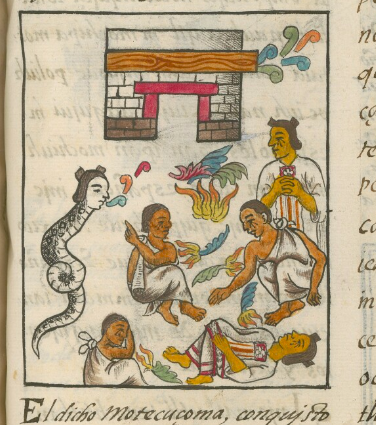Cihuacoatl (FCbk8f2v-3r)
This compound glyph (or something like a glyph) for the name of the divine force Cihuacoatl (literally, “Female-Serpent”) shows the head of a woman (cihuatl) in place of the head of a vertical, coiled serpent (coatl). The woman’s head shows the traditional sedentary, married woman’s hairstyle, the neaxtlahualli. Three speech scrolls emerge from her mouth, each one a different color (from her mouth upward the colors are: turquoise blue, orange, and red). The accompanying text describes Cihuacoatl as going “around at night crying through the streets of Mexico” City (translation by León García-Garagarza, 2023). Finally, in the compound glyph, the serpent’s white belly is segmented, and its back is gray with small circles or diamond shapes.
Stephanie Wood
The text (not really a gloss) that refers to this image comes from the previous folio, 2v, and it is hyphenated. We have merged the two parts into one. For a better understanding whether this is actually a glyph, see two glyphs for Cihuacoatl, below. They are both from the Matrícula de Huexotzinco. Like the image here, one of them replaces the serpent’s head with a woman’s head. But in that case, the woman’s hair is hanging down. In the other example, below, the woman’s head sits atop the serpent’s head. Of the two below, one serpent has a curved body and the other has a coil at mid-point. One is spotted and one is not. So, the details can vary, but the essentials are a serpent of some sort and the head of a woman of some sort, somewhere in the mix.
Stephanie Wood
cioacoatl
Cihuacoatl
Stephanie Wood
1577
Jeff Haskett-Wood
serpiente, serpientes, cohuatl, mujer, mujeres, fuerzas divinas, volutas, nombres de deidades

Cihuacoatl, literally “female serpent,” a divine force/deity, https://nahuatl.wired-humanities.org/content/cihuacoatl
cihua(tl), woman, https://nahuatl.wired-humanities.org/content/cihuatl
coa(tl), serpent or snake, https://nahuatl.wired-humanities.org/content/coatl
literalmente, Mujer-Serpiente
Stephanie Wood
Available at Digital Florentine Codex/Códice Florentino Digital, edited by Kim N. Richter and Alicia Maria Houtrouw, "Book 8: Kings and Lords", fol. 3r, Getty Research Institute, 2023. https://florentinecodex.getty.edu/en/book/8/folio/3r/images/0 Accessed 22 June 2025.
Images of the digitized Florentine Codex are made available under the following Creative Commons license: CC BY-NC-ND (Attribution-NonCommercial-NoDerivs 4.0 International). For print-publication quality photos, please contact the Biblioteca Medicea Laurenziana ([email protected]). The Library of Congress has also published this manuscript, using the images of the World Digital Library copy. “The Library of Congress is unaware of any copyright or other restrictions in the World Digital Library Collection. Absent any such restrictions, these materials are free to use and reuse.”




